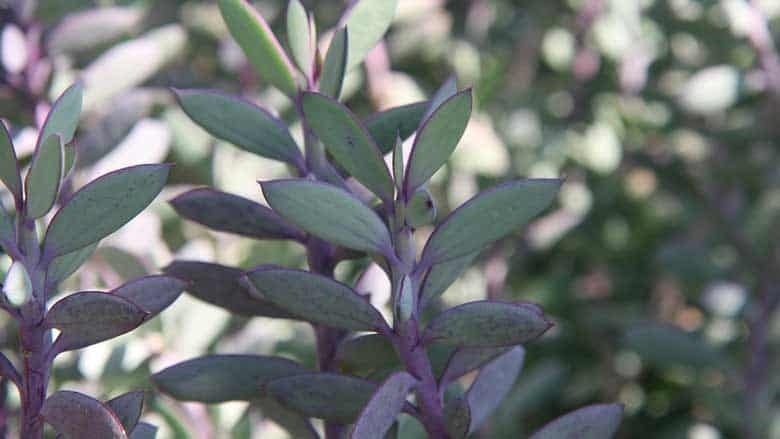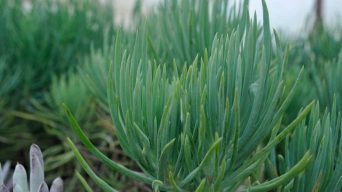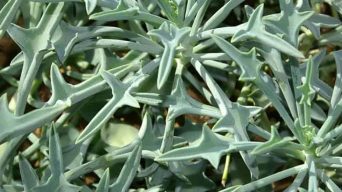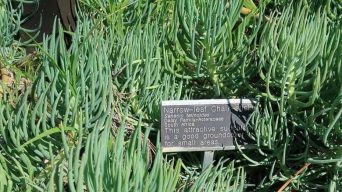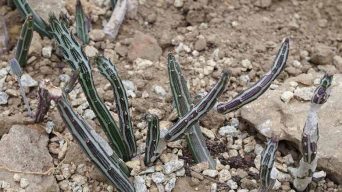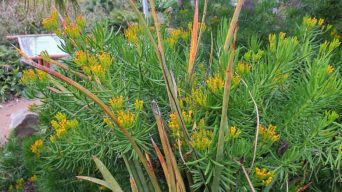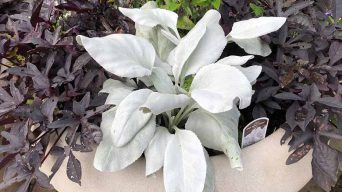It is not always easy to take care of a succulent, especially if you’re starting out.
The Senecio crassissimus is a succulent plant that has become popular in recent years due to its ease of propagation and low maintenance requirements.
As such, it’s no surprise that many people want to get their hands on one for themselves.
This article will provide you with all of the information you need to take care of and propagate the Senecio crassissimus plant.
Overview
The Senecio genus is one of the larger genera in the family Asteraceae.
It is a perennial, winter-growing through spring-blooming cluster composed mainly of annuals and perennials native to dry places.
The Senecio crassissimus succulent plant is native to Madagascar. It is also commonly known as:
- Vertical Leaf Senecio
- Lavender Steps
- Propeller Plant
- Vertical Leaf
Senecio crassissimus grows to an average height of 24 inches (60 cm) and a width of 18 inches (45 cm).
This Senecio species, the Senecio crassissimus, has fleshy leaves that are blue-green and have purple edges.
It also has flat leaves that are able to change direction without ever being in the sun’s direct path.
This plant blooms from about mid-summer until early autumn. It is characterized by yellow daisy-type flowers that appear on stalks up to 2′ tall.
How To Care for Senecio Crassissimus (Vertical Leaf Senecio)
Senecio Crassissimus care is easy because it is a tropical succulent, meaning it can be grown indoors with little to no attention.
But if you want to give it a little extra attention, then some tips can help keep your Senecio Crassissimus healthy and looking good.
Sun Exposure & Light Requirements
The Senecio crassissimus succulent plant needs to be in bright indirect light.
The plant is moderately light-sensitive and will begin to suffer if it does not receive enough natural sunlight.
The Senecio crassissimus succulent plants need at least four hours of indirect light per day, but more than that would be best for your plant’s health.
You should also ensure that there are no direct sun rays on any part of your Senecio crassissimus, as this can cause sunburns on the succulent.
If you want your Senecio crassissimus to flower, it needs a minimum of eight hours of light per day.
For this reason, the plant is also often grown under artificial lights. The bright sunlight and artificial light reaching the Senecio Crassissimus succulent plant will result in larger leaves.
The best time for these plants is morning sun exposure because they can tolerate early afternoon exposure without too much difficulty (as long as there is no direct sunlight).
Since they need so much bright indirect natural or artificial light, many people grow them at their windowsills or outside on sunny patios to maximize their potential.
Watering Requirements
The Senecio crassissimus succulent is a very drought-tolerant plant. It should be watered less than other plants.
When watering, make sure the soil has dried out before doing so again.
Ensure you don’t overwater it since this will rot the plant’s roots.
The best way to tell whether or not your succulent needs watering, poke your finger into the dirt until it’s about two inches deep to see if the soil is moist.
A good rule of thumb for watering your Senecio plant is that once every three days is enough and will help create healthy roots and prevent overwatering, which can lead to root rot in plants.
Soil Requirements
Senecio crassissimus succulents require a well-draining sandy soil. It’s best to use a cactus potting soil mix or other types of succulent-friendly soils.
A common mistake is to use soil that doesn’t drain well. The plant will likely rot and die, so it’s essential to make sure the soil is well-draining.
Make sure your potting mix drains water properly by adding sand or perlite if needed.
You can also use a commercial succulent mix that includes fertilizer in each soil bag for an added nutrient boost.
Temperature and Humidity
Senecio crassissimus is native to the western region of Madagascar.
The plant typically grows in a very dry environment with temperatures that range from 20°C (68°F) up to 30°C (86°F).
Temperatures below 18°C (64°F) can cause Senecio crassissimus plants to go into dormancy, which means they will lose their leaves and stop growing.
Senecio crassissimus will be able to grow well if the humidity is not too high. Still, it does require a minimum of 50% relative humidity year-round.
Fertilizing
Senecio crassissimus succulents do not need to be fertilized with traditional chemical fertilizers. Instead, you can use organic compost that is rich in nitrogen and potash for the best results.
If your soil does not contain these nutrients naturally or has become depleted over time due to constant usage by succulent plants, then a slow-release fertilizer should work well.
When fertilizing a succulent, the most important thing to remember is that they do not need very much because their root system can’t access nutrients deeply underground.
Potting and Repotting
Senecio crassissimus plants can grow in small pots, but they will need to be repotted soon.
The plant has delicate roots that are not meant for large containers because it cannot provide the right amount of nutrients and water.
These succulent plants also prefer a well-drained soil mix with coarse sand or perlite as an amendment during potting. It is best to use a clay pot to prevent root rot from excess moisture.
An excellent way to take care of Senecio crassissimus plants is by transplanting them every two years into fresh soil so their growth does not get stunted.
The process entails gently removing the plant’s old container (using gloves) before wrapping its roots in damp sphagnum moss or peat.
The soil should be pressed firmly around the roots and watered thoroughly.
For plants in pots, simply remove the old pot from its base before watering it with a sprinkler can to ensure that all of the root ball is moistened sufficiently.
Pruning
Pruning is necessary to keep the plant from becoming too dense and leggy.
Pinch off succulent leaves that are falling over near the ground or touching other plants.
Remove any dead parts of the stem by cutting them away with a sharp knife, following along where they curve.
Cut back stems at least halfway down to stimulate new growth in springtime.
To get extra-long stems, cut back the stem at a 45-degree angle.
This will cause side branches to grow out and create long stalks that can be up to three feet in length.
These are great for making centerpieces or hanging from the ceiling when used as an indoor plant!
Pests and Diseases
Some pests and diseases can affect the Senecio crassissimus.
These include most of those that are common for other garden plants, such as aphids, mealybugs, spider mites, thrips, or whiteflies.
Ants may also be a problem if they walk on the leaves of this plant during dry weather because their feet cause blisters to form, turning black and falling off quickly.
The most common disease that affects the Senecio crassissimus is powdery mildew, a fungal infection.
The symptoms of this can be seen on the leaves as they become covered in white or gray patches and eventually turn yellow.
It’s best to treat the plant with a fungicide in case of infection.
Some other pests and diseases that affect this succulent are rot, leaf spot, or rust, which causes reddish-brown spots to form on the leaves.
Other problems may be caused by viruses transmitted by aphids or mealy bugs.
As pests and diseases can be a problem for Senecio crassissimus plants, it is also advisable to keep an eye on any insects or diseases in order to take steps early enough before they become severe problems.
How to Care for Senecio Crassissimus in Winter
The Senecio crassissimus is a perennial succulent plant that can grow to be quite extensive.
Senecio crassissimus are known to be quite cold-hardy plants. They can even withstand frost and snow.
But it would be best to protect them from the elements by covering their soil with mulch or planting them in a container that will provide some protection.
In general, they require little attention during winter as long as they have enough light and water.
The first thing to do is make sure they have enough light.
During winter, the sun will not be as intense, and it can be harder for succulents to get their daily dose of sunlight.
You may need to supplement natural lighting with artificial lights, such as fluorescent or full-spectrum bulbs if you expect cloudy days during the daytime hours.
The next step in caring for a Senecio crassissimus plant is watering it adequately but sparingly.
Only give them a little bit of water every week, never more than what’s necessary, because overwatering will cause rot. The soil should be dry to the touch before watering.
Lastly, avoid fertilizing during the winter months to avoid stimulating growth. The Senecio crassissimus needs the rest and will be able to grow again when spring arrives!
How To Propagate Senecio Crassissimus (Vertical Leaf Senecio)
To propagate Senecio crassissimus, you can use the cutting method.
This is where you take a healthy stem with at least three leaves from an adult plant and cut it off about one inch below each leaf node.
You then place this cutting in soil or sand to root out new plants.
To root succulents, you must maintain moist soil or sand.
If there is any sign of wilting during the rooting process, it means that your plant needs more water and should be watered thoroughly.
You will need to wait until at least four leaves have emerged from each cutting before planting them into pots for sale or use in your home garden.
When propagating Senecio crassissimus using this method, new plants typically take between two weeks and three months to mature enough for transplanting outdoors as long as they are properly cared for.
The roots will develop slowly at first but then rapidly grow if given proper care.
Is the Senecio Crassissimus Toxic?
Senecio succulents are known to be toxic.
Consumption can cause fatal liver disease in animals when consumed in large quantities over a long period of time.
You should follow a few safety precautions when working with the Senecio crassissimus plant.
Keep the plant out of reach of pets and small children. Use good gardening gloves when handling the Senecio crassissimus or any other plants to avoid possible skin irritation.
If you experience any irritation or after your skin touches the plant, wash thoroughly with soap and water.
Final Thoughts
Senecio crassissimus care and propagation are not difficult. It only takes a few minutes each day, and it can be done in any location.
This is the perfect plant for people who are busy because there is minimal maintenance.
However, it does have a few needs that the owner should be aware of.
If you follow these simple recommendations for Senecio crassissimus care and propagation, then your plant will live a long time with just as much beauty as when it was first purchased!

